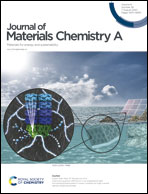An intriguing window opened by a metallic two-dimensional Lindqvist-cobaltporphyrin organic framework as an electrochemical catalyst for the CO2 reduction reaction†
Abstract
Adequate studies have confirmed that polyoxometalates (POMs) are preeminent multi-electron donors and metalloporphyrins are electrochemically generated active catalysts for the CO2 reduction reaction. Integrating electron-rich POMs with metalloporphyrins in a metallic and stable organic framework can create facile and fascinating heterogeneous electrochemical catalysts by merging their complementary advantages and extensive promising possibilities. Herein, we designed and screened a series of stable and metallic two-dimensional (2D) polyoxometalate–metalloporphyrin organic frameworks (TM–PMOFs, TM in porphyrin = Fe, Co, Ni, Cu, Zn, Ru, Rh, Pd, Os, Ir, or Pt) constructed by linking reductive Lindqvist-type hexamolybdate ([Mo6]2e/2H) with 4-connected tetra-(4-aminophenyl) metalloporphyrin (TM-TAPP) building structs through the Mo![[triple bond, length as m-dash]](https://www.rsc.org/images/entities/char_e002.gif) N triple bond, whose CO2 electrochemical reduction performances and processes are studied in detail by means of density functional theory (DFT). Our computations reveal that the Lindqvist-type clusters [Mo6]2e/2H act as multi-electron regulators for the reduction reaction, and then the most promising catalyst for the reduction from CO2 to CH4 has the lowest theoretical driven potential (0.41 V). Moreover, the [Mo6]2e/2H units inside are easily reduced from the [Mo6] with a driven potential (0.08 V). Our work will encourage more experimental studies to further explore metallic 2D PMOF materials for CO2 electrochemical reduction.
N triple bond, whose CO2 electrochemical reduction performances and processes are studied in detail by means of density functional theory (DFT). Our computations reveal that the Lindqvist-type clusters [Mo6]2e/2H act as multi-electron regulators for the reduction reaction, and then the most promising catalyst for the reduction from CO2 to CH4 has the lowest theoretical driven potential (0.41 V). Moreover, the [Mo6]2e/2H units inside are easily reduced from the [Mo6] with a driven potential (0.08 V). Our work will encourage more experimental studies to further explore metallic 2D PMOF materials for CO2 electrochemical reduction.



 Please wait while we load your content...
Please wait while we load your content...